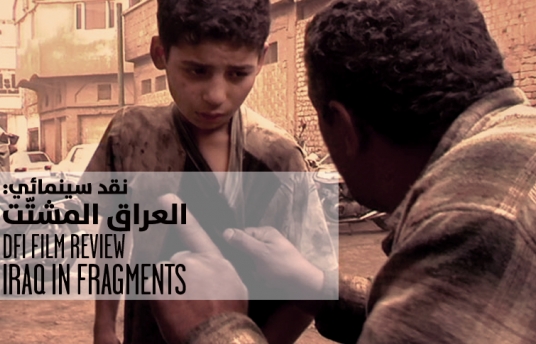DFI Film Review: Iraq in Fragments (2006)
Sep 25, 2011

Written by Reem Saleh, New Media, DFI
Film: Iraq in Fragments
Year: 2006
Director: James Longley
Stars: Mohammed Haithem and Suleiman Mahmoud
Genre: Documentary
Set in Iraq after the fall of dictator Saddam Hussein, the country is now ruled by foreign forces. What was supposed to be the rise of freedom appears to breaking down of the country, into fragments.
This Oscar nominated documentary offers a selection of Iraqi vignettes filmed over a period of one year (2003-04) for a better understanding of the internal repercussions of a war-torn country. ‘Iraq in Fragments’ shows three different points of views from Sunnis, Shias and Kurds and told mainly by the most genuine of witnesses: children.
The first chapter opens with Sunni Mohammad, an 11-year-old orphan living with his uncle. Dragged too soon into the workspace, little is left to this tormented young man who seems to lose what kids do best, his ability to dream.
Mohammad seems to accept his tough conditions of working, being screamed at, bullied for not being able to write his father’s name and punished for leaving work to play with other kids. But what else is left for him? Imposing forces manipulate his future.
Mohammad wants to go to school but he’s intimidated by the fact that he’s four years older than his classmates and working in an auto-repair shop. But, he is still able to formulate his own opinion about the country and foreign US forces, something he’s probably adopted from grown-ups, but which he describes in his own innocent voice. For him, electing a new president means changing their morning anthem at school “ we must sing a different song if another president comes, we must sing differently”.
Mohammad longs for a beautiful past he knows little of. All he remembers from it are fixed bridges, a clean sea and colourful fish. His new reality consists of streets filled with smoke, tanks, soldiers and destruction. Through Mohammad’s eyes, the film opens with a gold fish covering the city of Baghdad: a transitional element suggestive of life and dreams..
Mohammad is scared at night, but continues to dream of his future by hoping to become a pilot. “I want to fly the plane,” he says, “to see a place that’s beautiful and nice. Not Iraq, but a beautiful place. I imagine I’m high in the sky. I can see the birds, I fly down to those countries … the beautiful ones”. Unfortunately for Muhammad, his life doesn’t seem to bring him closer to his dreams.
The second chapter of the film, titled “Sadr’s South” refers to the followers of the Shia cleric Muqtada al-Sadr in the midst of preparing an election campaign. The group is determined to enforce Islamic law. They accuse Saddam Hussein of provoking religious conflicts, have been encouraged in this path by outside, imperialist forces. This group longs for a perceived justice, fed by anger and bitterness. Not surprisingly, they clash with American soldiers.
The third and last chapter takes us to a more peaceful Iraqi Kurdistan filled with workers tending crops and making bricks. They are more tolerant towards foreign troupes and enjoying a sense of autonomy. According to them, the conflict has helped removed the tyrant, Saddam. At the same time, though, local elders believe that there’s too much ideological bloodshed between Iraqis making it impossible to be happy and at peace, even as removed as they are from the most intense fighting. Again in Kurdistan, against a background of enchanting music, Iraq’s children are the ones to verbalize the wisest of words: “ Iraq is not something you can cut into pieces. Iraq is country, how can you cut a country with a saw?”
Filmmaker James Longley presents three beautiful visions of Iraq, as the nation struggles to its feet following the American invasion. It is a striking and powerful film, filled with expressive silences, and personal close-ups on faces and eyes. Longley completely erased traditional means of documentary with commentary voice-overs and straight-to-the-camera clichéd interviews. Instead, he fuses strong images of his characters with their own narration, a far more powerful combination. While people go about their lives and daily tasks, we hear them thinking loud. It allows us rare glimpses of their reality from a healthy observational distance. The resulting film is a compelling, intimate, and non-judgmental portrait of this conflict area, using simple yet innovative techniques, breaking the rules of traditional documentary making.
Iraq In Fragments - Trailer
المقطع الاعلاني لفيلم العراق المشتّت